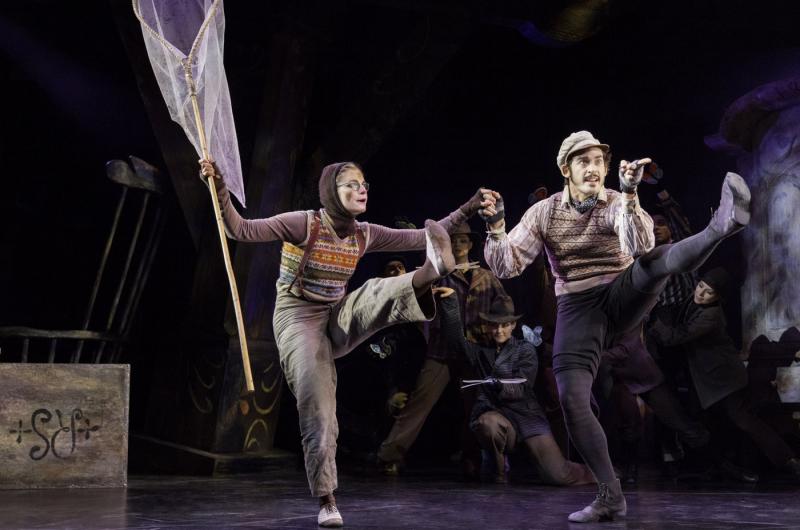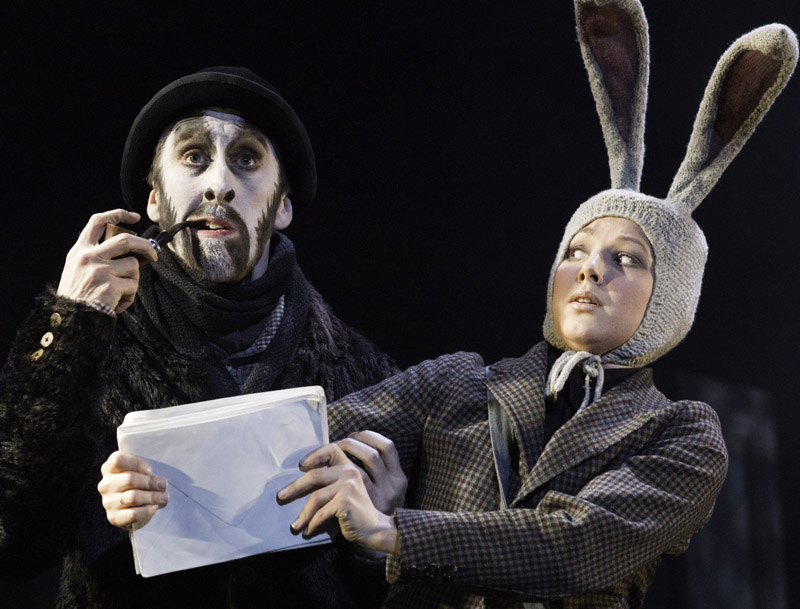The Wind in the Willows, Duchess Theatre | reviews, news & interviews
The Wind in the Willows, Duchess Theatre
The Wind in the Willows, Duchess Theatre
A lovingly polished gem for all the family makes its West End début

The first Royal Opera House production to transfer to the West End stage, and Tony Robinson’s first theatre role in 16 years, is a dance-drama version of a children’s book about animals and features a man in a car costume being chased by comedy coppers during the interval. Dumbing down, do I hear you cry? Not a bit of it.
Personally, I think one of the best things about the Christmas season is the effort made by purveyors of “high” culture to be more accessible to children: see The Nutcracker, Britten’s St Nicolas, Prokofiev's Peter and the Wolf. Like these august efforts, Will Tuckett’s charming production of The Wind in the Willows is far from populist pandering, but rather a pitch-perfect telling of a heart-warming story about friendship and adventure. And the pernicious threat to the English countryside from modernisation, industrialisation and social change, obviously – see also those other classics of early 20th-century children’s literature, The Lord of the Rings, the Narnia books, and T H White’s The Once and Future King – but Tuckett goes reasonably easy on the conservative message (his casting of the naughty, disruptive weasels as gleeful rockers in Elvis wigs makes modernisation and social change look pretty awesome, actually).
 Tony Robinson as Kenneth Grahame narrates the story, and though his long break from theatre work shows in the occasional missed or mumbled word, his kindly, twinkly demeanour is just right; he shows us an author with real affection for his characters, and real joy in the world he conjures up. The other characters are superbly cast: Cris Penfold (pictured right) makes a skittish, Bertie Wooster-ish Toad, Christopher Akrill a grave, down to earth (and Northern) Badger (pictured below), Ewan Wardrop a pricelessly funny Gaoler’s Daughter (who doesn’t love to see a big man in a floral pinny?) as well as a smooth and not-all-that-villainous Chief Weasel. Will Kemp as Ratty reprises a role he created, and I wonder if perhaps he is a little weary of it now; he sparkled less than the others. But Clemmie Sveaas more than compensated with her adorably engaging portrait of Mole, who she makes at once timid and graceful: whether sitting to catch an apple or jumping to catch butterflies, Sveaas has a really captivating quality of movement.
Tony Robinson as Kenneth Grahame narrates the story, and though his long break from theatre work shows in the occasional missed or mumbled word, his kindly, twinkly demeanour is just right; he shows us an author with real affection for his characters, and real joy in the world he conjures up. The other characters are superbly cast: Cris Penfold (pictured right) makes a skittish, Bertie Wooster-ish Toad, Christopher Akrill a grave, down to earth (and Northern) Badger (pictured below), Ewan Wardrop a pricelessly funny Gaoler’s Daughter (who doesn’t love to see a big man in a floral pinny?) as well as a smooth and not-all-that-villainous Chief Weasel. Will Kemp as Ratty reprises a role he created, and I wonder if perhaps he is a little weary of it now; he sparkled less than the others. But Clemmie Sveaas more than compensated with her adorably engaging portrait of Mole, who she makes at once timid and graceful: whether sitting to catch an apple or jumping to catch butterflies, Sveaas has a really captivating quality of movement.
Nicky Gillibrand’s costumes and Jo Tuplin’s wigs and make-up evoke the animals with a light and often humorous touch: chartreuse-green hair for Toad, a shiny Mackintosh and pencil moustache for Ratty, long knitted ears for rabbits (pictured below). The delicacy and cleverness of the costumes astonishes and seduces: Badger’s coat is cut away in just the curve of a real badger’s long back; Mole’s thick round glasses and balaclava precisely evoke the little animal’s head, while her homely, innocent friendliness is conveyed by the best hand-knitted Fair Isle vest this side of BBC2’s Wartime Farm (see main picture).
Composer Martin Ward steeped himself in the music of George Butterworth, most English of composers, in order to create a sound world that evokes all our favourite rural idylls (Hobbiton, Cranford, Farthing Wood). It did seem slightly unnecessary to have the band miked in such a small theatre, particularly since Ward’s restrained orchestration lets the natural tones of his different instruments (just piano, violin, cello, flute, bass clarinet, basson) really sing.
 The ingenious attic set design by the Quay Brothers constantly provokes admiration, with furniture of all kinds being pressed into service as Grahame’s woodland realm: a blue river unfurls from a drawer; an upended chair back provides the bars for a prison cell, and a wooden rocking horse is hitched to a wardrobe (standing in for a caravan) and set merrily rocking by Toad, who is apparently a dangerous driver even of livestock.
The ingenious attic set design by the Quay Brothers constantly provokes admiration, with furniture of all kinds being pressed into service as Grahame’s woodland realm: a blue river unfurls from a drawer; an upended chair back provides the bars for a prison cell, and a wooden rocking horse is hitched to a wardrobe (standing in for a caravan) and set merrily rocking by Toad, who is apparently a dangerous driver even of livestock.
Tuckett’s Wind in the Willows is now 10 years old, and some of the actors have played their woodland characters in dozens of performances over multiple runs, but the delight, the joy, the affection palpable in all aspects of this production appear both fresh and unfeigned. I left not only rejuvenated by a good giggle, but uplifted by good storytelling, the kind that draws you in completely and leaves you feeling – as Robinson says at the end – like “all that makes us us has changed.” That’s exactly what theatre should do, at any age and in any season.
- The Wind in the Willows is at the Duchess Theatre until 1 February 2014.
rating
Buy
Explore topics
Share this article
The future of Arts Journalism
You can stop theartsdesk.com closing!
We urgently need financing to survive. Our fundraising drive has thus far raised £49,000 but we need to reach £100,000 or we will be forced to close. Please contribute here: https://gofund.me/c3f6033d
And if you can forward this information to anyone who might assist, we’d be grateful.

Subscribe to theartsdesk.com
Thank you for continuing to read our work on theartsdesk.com. For unlimited access to every article in its entirety, including our archive of more than 15,000 pieces, we're asking for £5 per month or £40 per year. We feel it's a very good deal, and hope you do too.
To take a subscription now simply click here.
And if you're looking for that extra gift for a friend or family member, why not treat them to a theartsdesk.com gift subscription?
more Dance
 'We are bowled over!' Thank you for your messages of love and support
Much-appreciated words of commendation from readers and the cultural community
'We are bowled over!' Thank you for your messages of love and support
Much-appreciated words of commendation from readers and the cultural community
 R:Evolution, English National Ballet, Sadler's Wells review - a vibrant survey of ballet in four acts
ENB set the bar high with this mixed bill, but they meet its challenges thrillingly
R:Evolution, English National Ballet, Sadler's Wells review - a vibrant survey of ballet in four acts
ENB set the bar high with this mixed bill, but they meet its challenges thrillingly
 Like Water for Chocolate, Royal Ballet review - splendid dancing and sets, but there's too much plot
Christopher Wheeldon's version looks great but is too muddling to connect with fully
Like Water for Chocolate, Royal Ballet review - splendid dancing and sets, but there's too much plot
Christopher Wheeldon's version looks great but is too muddling to connect with fully
 iD-Reloaded, Cirque Éloize, Marlowe Theatre, Canterbury review - attitude, energy and invention
A riotous blend of urban dance music, hip hop and contemporary circus
iD-Reloaded, Cirque Éloize, Marlowe Theatre, Canterbury review - attitude, energy and invention
A riotous blend of urban dance music, hip hop and contemporary circus
 How to be a Dancer in 72,000 Easy Lessons, Teaċ Daṁsa review - a riveting account of a life in dance
Michael Keegan-Dolan's unique hybrid of physical theatre and comic monologue
How to be a Dancer in 72,000 Easy Lessons, Teaċ Daṁsa review - a riveting account of a life in dance
Michael Keegan-Dolan's unique hybrid of physical theatre and comic monologue
 A Single Man, Linbury Theatre review - an anatomy of melancholy, with breaks in the clouds
Ed Watson and Jonathan Goddard are extraordinary in Jonathan Watkins' dance theatre adaptation of Isherwood's novel
A Single Man, Linbury Theatre review - an anatomy of melancholy, with breaks in the clouds
Ed Watson and Jonathan Goddard are extraordinary in Jonathan Watkins' dance theatre adaptation of Isherwood's novel
 Peaky Blinders: The Redemption of Thomas Shelby, Rambert, Sadler's Wells review - exciting dancing, if you can see it
Six TV series reduced to 100 minutes' dance time doesn't quite compute
Peaky Blinders: The Redemption of Thomas Shelby, Rambert, Sadler's Wells review - exciting dancing, if you can see it
Six TV series reduced to 100 minutes' dance time doesn't quite compute
 Giselle, National Ballet of Japan review - return of a classic, refreshed and impeccably danced
First visit by Miyako Yoshida's company leaves you wanting more
Giselle, National Ballet of Japan review - return of a classic, refreshed and impeccably danced
First visit by Miyako Yoshida's company leaves you wanting more
 Quadrophenia, Sadler's Wells review - missed opportunity to give new stage life to a Who classic
The brilliant cast need a tighter score and a stronger narrative
Quadrophenia, Sadler's Wells review - missed opportunity to give new stage life to a Who classic
The brilliant cast need a tighter score and a stronger narrative
 The Midnight Bell, Sadler's Wells review - a first reprise for one of Matthew Bourne's most compelling shows to date
The after-hours lives of the sad and lonely are drawn with compassion, originality and skill
The Midnight Bell, Sadler's Wells review - a first reprise for one of Matthew Bourne's most compelling shows to date
The after-hours lives of the sad and lonely are drawn with compassion, originality and skill
 Ballet to Broadway: Wheeldon Works, Royal Ballet review - the impressive range and reach of Christopher Wheeldon's craft
The title says it: as dancemaker, as creative magnet, the man clearly works his socks off
Ballet to Broadway: Wheeldon Works, Royal Ballet review - the impressive range and reach of Christopher Wheeldon's craft
The title says it: as dancemaker, as creative magnet, the man clearly works his socks off
 The Forsythe Programme, English National Ballet review - brains, beauty and bravura
Once again the veteran choreographer and maverick William Forsythe raises ENB's game
The Forsythe Programme, English National Ballet review - brains, beauty and bravura
Once again the veteran choreographer and maverick William Forsythe raises ENB's game

Add comment